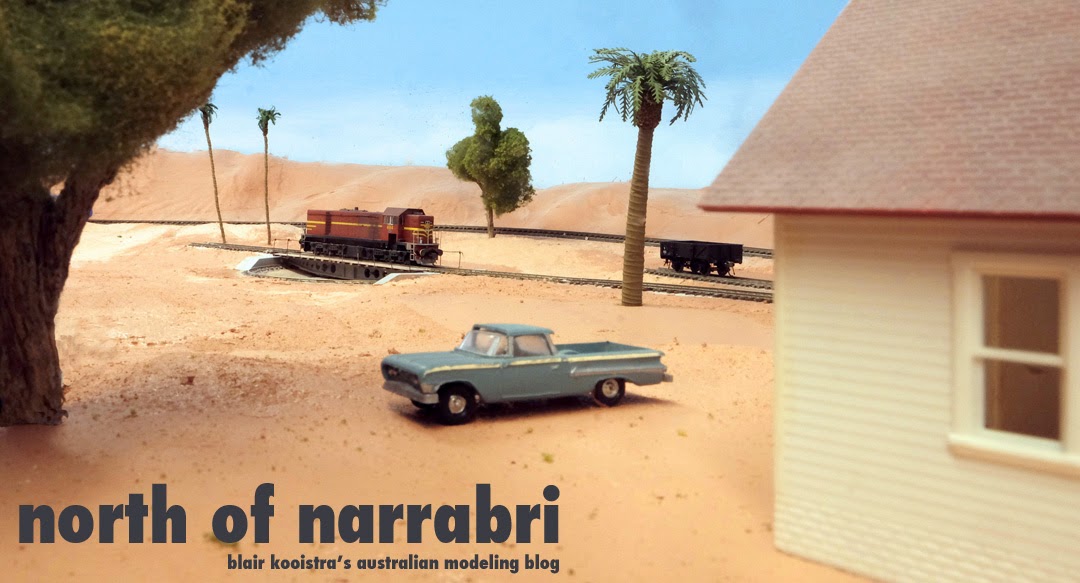 The shadow-box effect in a darkened room. . .Just got a package in the m
The shadow-box effect in a darkened room. . .Just got a package in the mail containing a few T4 "low profile" fluorescent lights I'd ordered on ebay, and I think they'll do quite nicely to light the layout.
I've always wanted a layout with a "shadow box" presentation--ideally a dark room with just the layout fully illuminated like a museum diorama. But, living in Texas, a layout built in any sort of "bonus room" will have a soaring 10-12' high ceiling. (The best space for a layout, I'm thinking, is in a basement with 7' or so ceilings, low enough to hang your lighting from not too far above the layout and lending itself to such a shadow box effect.) With the last two layouts I've built, I'd resorted to hanging cheap "Lights of America" dual T12 fluorescent tubes at the ends of chains dangling from the high ceilings--a lower-cost solution and alternative to building a valance above the layout (essentially constructing a whole other level of benchwork to attach the lighting to)--but one that doesn't look nearly as "finished" as the shadow box design.
With the Narrabri layout, the "finished layout room" ideal is one of my goals--no hanging light fixtures at the end of chains, and hopefully, no unsightly open storage area under the shelved layout sections. Eventually, the whole layout will be "finished" and blend into the room, which will someday also be used as sort of an upstairs home theater as well.
 Size comparison: T12 tube on left; T4 tube AND fixture on the right. . . and the T4 puts out just as much light and uses 30% less energy. . .
Size comparison: T12 tube on left; T4 tube AND fixture on the right. . . and the T4 puts out just as much light and uses 30% less energy. . . Another size-comparison. . . .
Another size-comparison. . . .Back to those T4 tubes. They're not commonly found in your neighborhood Home Depot or Lowes; usually you'd have to go to specialty lighting stores or perhaps an "indoor gardening" store (supplying, well, high intensity lights for those who wish to grow "whatever" inside away from prying eyes). The T4 (and nearly identical T5) lights are very small in size compared to larger T8 and T12 tubes, and provide as much or more light with less wattage. . idea for use as under-deck lighting on a model railroad. Other modelers have tried "rope lights" with very little light output as well as strings of LED lighting which currently is quite expensive by comparison. Some "expert" have used compact fluorescent lights in screw-in fixtures, but wiring all these fixtures didn't sound like something I wanted to get involved in; besides, the pattern of light produced by these CFL's, to me, were less desirable for a narrow, linear layout than fluorescent tubes are.
These T4 fixtures are truly compact, 3/4" across and only 1 1/4" deep, so they're perfect for under my thin-profile layout decks. And they're bright--the 28W 46" long tube provides just as much illumination (2900+ lumens) than the much thicker 40W T12 equivalent and uses 30% less electricity. Five of the fixtures can be daisy-chained together on the same circuit. I figure I'll need a total of 17 fixtures for the railroad, a total of around 750 linear inches. On-line searching has found fixtures than can illuminate the railroad for around $.71 an inch; around $500 for the whole railroad. . .a bit more than using CFL's and screw in bases, but with, I feel, a better quality of light. Lighting--good lighting--isn't cheap. Figure the cost of at least a few locomotives to do it right.
 Fixtures attached to L-girder stiffeners along the front of the lighting valance. They can either be daisy-chained using short cords between fixtures, or butted next to each other using a small adapter.
Fixtures attached to L-girder stiffeners along the front of the lighting valance. They can either be daisy-chained using short cords between fixtures, or butted next to each other using a small adapter.With a half-hour of work, I had the first three "test" fixtures installed above Narrabri, and I was damned impressed by how they look. I've already ordered the rest of what I'll need to finish the layout, and I highly recommend these to others looking for an easy to install and compact lighting system for their shelf-type model railroad.
 Good, even lighting--and lots of it. Sorry for lack of depth of field. . this shot hand-held without a tripod.
Good, even lighting--and lots of it. Sorry for lack of depth of field. . this shot hand-held without a tripod.












